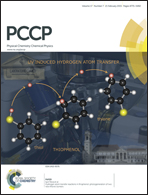Artificially maturated [FeFe] hydrogenase from Chlamydomonas reinhardtii: a HYSCORE and ENDOR study of a non-natural H-cluster†
Abstract
Hydrogenases are enzymes that catalyze the oxidation of H2 as well as the reduction of protons to form H2. The active site of [FeFe] hydrogenase is referred to as the “H-cluster” and consists of a “classical” [4Fe–4S] cluster connected via a bridging cysteine thiol group to a unique [2Fe]H sub-cluster, containing CN− and CO ligands as well as a bidentate azadithiolate ligand. It has been recently shown that the biomimetic [Fe2(adt)(CO)4(CN)2]2− (adt2− = azadithiolate) complex resembling the diiron sub-cluster can be inserted in vitro into the apo-protein of [FeFe] hydrogenase, which contains only the [4Fe–4S] part of the H-cluster, resulting in a fully active enzyme. This synthetic tool allows convenient incorporation of a variety of diiron mimics, thus generating hydrogenases with artificial active sites. [FeFe] hydrogenase from Chlamydomonas reinhardtii maturated with the biomimetic complex [Fe2(pdt)(CO)4(CN)2]2− (pdt2− = propanedithiolate), in which the bridging adt2− ligand is replaced by pdt2−, can be stabilized in a state strongly resembling the active oxidized (Hox) state of the native protein. This state is EPR active and the signal originates from the mixed valence FeIFeII state of the diiron sub-cluster. Taking advantage of the variant with 15N and 13C isotope labeled CN− ligands we performed HYSCORE and ENDOR studies on this hybrid protein. The 13C hyperfine couplings originating from both CN− ligands were determined and assigned. Only the 15N coupling from the CN− ligand bound to the terminal iron was observed. Detailed orientation selective ENDOR and HYSCORE experiments at multiple field positions enabled the extraction of accurate data for the relative orientations of the nitrogen and carbon hyperfine tensors. These data are consistent with the crystal structure assuming a g-tensor orientation following the local symmetry of the binuclear sub-cluster.
![Graphical abstract: Artificially maturated [FeFe] hydrogenase from Chlamydomonas reinhardtii: a HYSCORE and ENDOR study of a non-natural H-cluster](/en/Image/Get?imageInfo.ImageType=GA&imageInfo.ImageIdentifier.ManuscriptID=C4CP05426A&imageInfo.ImageIdentifier.Year=2015)

 Please wait while we load your content...
Please wait while we load your content...